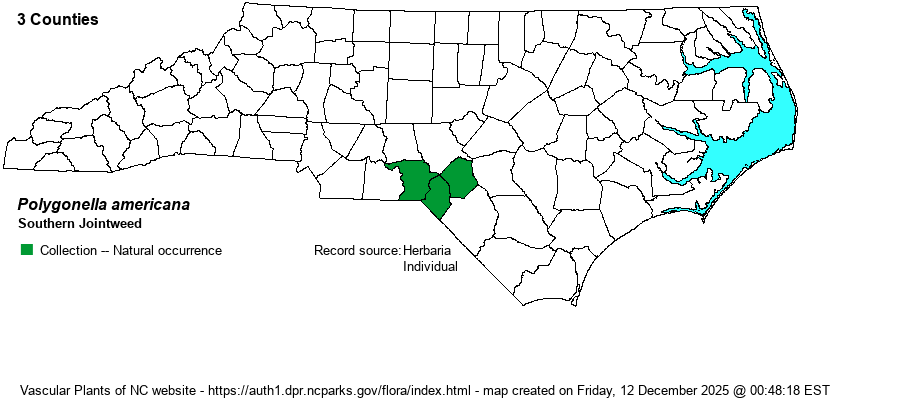| Author | (Fischer & C.A. Meyer) Small | |
| Distribution | Southern part of the Sandhills only; not yet found in heavily covered Cumberland and Moore counties. Although all populations are ruderal, they are probably native and natural extensions of those in SC, where widespread. Collections from Brunswick and Bladen counties on SERNEC do not have the specimens available for review; even if correct, they likely should be considered as Provenance Uncertain or Non-natural.
Coastal Plain, NC to southern GA and TX; inland locally to TN, AR, OK, NM. | |
| Abundance | Rare, with a scattering of populations known, though populations may consist of dozens of plants. The NCNHP has it now State Ranked as S1S2. Some references and agencies consider this species as likely adventive and not native to NC. Weakley (2024) does consider it native in NC, as do the website editors, for reasons mentioned above. It appears to be scarce enough to list it as Significantly Rare, but at least it is on the Watch List (W1). | |
| Habitat | Xeric openings and disturbances (roadsides, mown or burned clearings, military drop zones) within Longleaf Pine sandhills. | |
| Phenology | Flowering and fruiting mid June-October. | |
| Identification | Southern Jointweed is rather robust and very showy in flower. Its thick stems grow 2-3 feet tall and have wide-spreading inflorescence branches that are covered with bright white flowers. Its leaves are small and hardly noticeable at any distance. No other NC plant looks like it, as the other members of the genus are much shorter and more slender. | |
| Taxonomic Comments | A few recent authors have noted the genetic similarity of Polygonella to Polygonum and have lumped the two. Because the two can be easily told apart in the field, taxon editors, including Weakley (2018), prefer to recognize both genera. | |
| Other Common Name(s) | American Jointweed | |
| State Rank | S1S2 | |
| Global Rank | G5 | |
| State Status | W1 | |
| US Status | | |
| USACE-agcp | | |
| USACE-emp | | |

